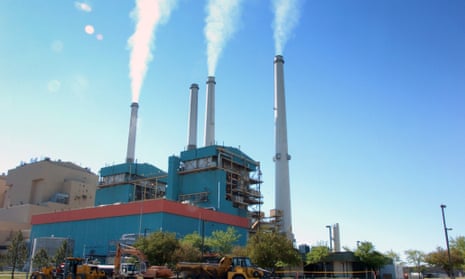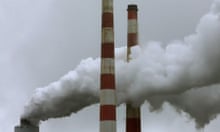The Obama administration unveiled historic environment rules cutting carbon pollution from power plants by 30% on Monday, spurring prospects for a global deal to end climate change but setting up an epic battle over the environment in this year's mid-term elections.
The new rules, formally announced by the Environmental Protection Agency, represent the first time Barack Obama, or any other president, has moved to regulate carbon pollution from power plants – the largest single source of carbon dioxide emissions that cause climate change.
The EPA said the regulations, which would cut carbon pollution from power plants 30% from 2005 levels by 2030, would “fight climate change while supplying America with reliable and affordable power”.
The EPA administrator, Gina McCarthy, said the new rules would be critical to Obama's efforts to deliver on his promise – to Americans and the international community – to fight climate change.
"The EPA is delivering on a vital piece of President Obama's climate action plan by proposing a clean power plan that will cut harmful carbon pollution from our largest source – power plants," she said in a statement.
“This is not just about disappearing polar bears and melting ice caps,” McCarthy said in a speech at EPA headquarters. “This is about protecting our health and protecting our homes. This is about protecting local economies and this is about protecting jobs.”
The new rules were not as ambitious as some environmental groups had hoped. America is already a third of the way towards meeting the national average of a 30% cut in emissions. Some states, especially those in the north-east, have already exceeded the standard.
Even so, reaction from environmental groups to the new power plant rules ranged from “momentous” to “historic”. Al Gore said the new rules were “the most important step taken to combat the climate crisis in our country's history”.
Michael Brune, executive director of the Sierra Club, said "today, the president made good on his promise to American families that his administration would tackle the climate crisis, and clean up and modernize the way we power our country."
In an initiative organised by Ceres, the green investor network, 128 companies and 49 investors managing $800 billion in assets, sent letters to the White House and leaders of both parties in Congress supporting the new rules as "a critical step" to dealing with climate change.
But a lobby group for the coal industry – which will be hit hardest by the new rules – said the regulations would hurt the economy and lead to power outages. “If these rules are allowed to go into effect, the administration, for all intents and purposes, is creating America's next energy crisis,” the American Coalition for Clean Coal Electricity said.
Obama had initially sought to deal with climate change through Congress. But after that effort collapsed, and with Republicans in Congress uniformly opposed to cutting carbon emissions – or even acknowledging climate change was occurring – Obama decided last year to use his executive authority to cut carbon pollution.
In her announcement on Monday, McCarthy hit back at criticism from industry and conservative groups that the rules will lead to power outages or higher electricity prices. “Critics say that their energy bills will skyrocket. Well, they're wrong,” she said.
McCarthy said the new rules would result in pollution savings that amount to "double what every power plant in America generated in the way of pollution in 2012."
The result, she said, would be lower medical bills and fewer trips to the emergency rooms, especially for kids with asthma, the elderly and infirm.
McCarthy says the plan "is also about environmental justice" because "lower-income families and communities of color are hardest-hit."
Emissions creeping up again
Power plants are the largest single source of carbon pollution, accounting for nearly 40% of the emissions that cause climate change.
Obama, in his weekly radio address on Saturday, said it was past time to set national limits on carbon dioxide emissions – just as the EPA has done for years with arsenic, mercury and other toxins.
“Right now, there are no national limits to the amount of carbon pollution that existing plants can pump into the air we breathe. None,” he said. “They can dump unlimited amounts of carbon pollution into the air. It's not smart, it's not safe, and it doesn't make sense.”
Carbon dioxide emissions from power plants had been falling since 2005, because of the economic downturn and because of the switch from coal to cheaper natural gas.
Ethan Zindler of Bloomberg New Energy Finance said the power industry was already about a third of the way towards the 30% goal.
But emissions crept up last year and again in the first months of 2014, and the regulations would put America on course for long term and lasting cuts to carbon pollution.
Andrew Steer, the chief executive of the World Resources Institute, said it was a “momentous development” for America's efforts to deal with climate change.
“It's the most important action available to cut US emissions – and the Obama administration has seized the opportunity,” he said. “These new standards send a powerful message around the world that it's time to face the global threat of climate change.”
The rules could affect 1,600 power plants. About 600 of these operate on coal, including many that are nearly 50 years old and will have the most difficulty meeting the new standards.
Under the rule, states and power companies will have a range of options to meet the new standards: switching from coal to cleaner-burning natural gas; forming cap-and-trade markets; expanding renewables such as wind and solar power; or encouraging customers to use less energy by moving to more efficient heating and cooling systems and appliances.
That's a departure for the EPA, which generally has focused on curbing emissions from specific smoke stacks.
But the Natural Resources Defense Council, which produced models that helped guide the EPA, said a system-wide approach would make it easier and cheaper for power companies to reach the new standard.
The 30% national target will not be applied uniformly across the country. The EPA will set individual reductions targets for each state, taking into account their energy mix, according to those briefed on the plan.
States have until 2016 to come up with a strategy for meeting the targets. However, the EPA rules will not come into force in all states until 2020, according to one individual briefed on the plan.
“They are not going to spread it out smoothly all over the place like creamy peanut butter,” said Vicki Arroyo, who heads the climate centre at the Georgetown University law school. “It's going to be more lumpy than that. Some states will have less ambitious targets, and some states will have more.”
The idea is to take account of the available energy sources in each state, as well as the measures some states have already undertaken to cut carbon pollution. North-eastern states have already cut their power plant emissions by 40% compared with 2005.
McCarthy said Monday the plan is tailored for the states. "The glue that holds this plan together ... is that each state's goal is tailored to their own circumstances ... each state's different, so each goal, and each path, can be different," she said.
Arroyo said it was possible the rule could bring about the same level of reductions in carbon pollution as a climate change bill that was defeated by Congress five years ago.
The new EPA rule bypasses Congress, relying on Obama's executive authority and supreme court decisions, to propose new rules under the Clean Air Act.
The Chamber of Commerce, the country's biggest business lobby, said last week the new rules would cost the economy $51bn and put 224,000 people out of work.
Coal-mining companies, some power companies and Republican state officials have accused the EPA of overstepping its authority, and will be studying the bill closely for possible legal challenges.
In their rebuttal to Obama's radio address, the Republicans said the new standards would "kill coal" and lead to power outages.
"We'll all be paying a lot more money for electricity – if we can get it," said Wyoming senator Mike Enzi.
But Obama has been marshalling his own supporters. Environmental and public health groups have been pushing hard for the new rules.
Researchers from Harvard and Syracuse universities put out a study last week saying that curbs on carbon pollution would also reduce smog and soot, avoiding premature deaths from heart attacks and lung disease.
That campaign effort is due to pick up again on Monday. Obama is scheduled to hold a conference call with the American Lung Association and other public health groups on Monday afternoon.
White House officials spent Sunday briefing governors and business leaders about the new rule.









Comments (…)
Sign in or create your Guardian account to join the discussion